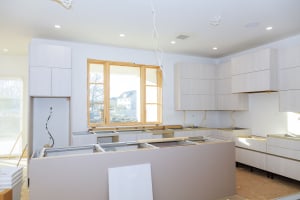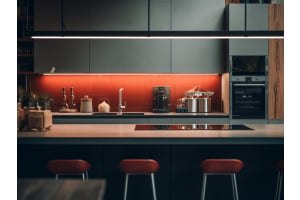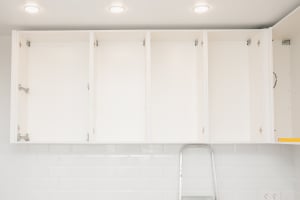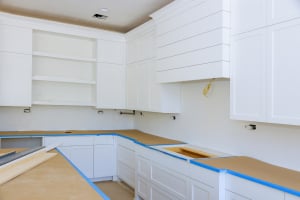The right kitchen cabinets can transform your kitchen and offer the perfect solution for hiding away items while filling awkward-shaped nooks and crannies to make the most of every available space in your kitchen.
If you lack the space for a full walk-in pantry, a kitchen pantry cabinet can be a great alternative and a way to make sure that you have your kitchen essentials nearby when you need them. Nobody has time to be rifling through drawers in the middle of a complicated recipe.
Whether you are an experienced carpenter or this is your first foray into kitchen design, we have put together the ultimate step-by-step guide to help you build pantry cabinets.
What Is a Pantry Cabinet?
A pantry cabinet is a cabinet in the kitchen that is designed to hold dry goods, ingredients, equipment, and other items that you use frequently. There are many advantages of a pantry cabinet over other options–pantries are typically more affordable, take up less space, and can be installed easily, making them a popular choice for homeowners.
What You Will Need
To start creating your own pantry cabinet, you will need the following essentials:
- Sheet of plywood
- Pocket hole jig
- Quarter-inch pocket hole screws
- Drill
- Sander and sandpaper
- Edge banding and edge-banding trimmer
- Square
- Corner clamps
- Cabinet door and hinges
- Concealed hinge jig
- Paint or stain
- Two one-half-inch cabinet screws
- Level
- Shims
- Stud finder
How to Assemble Cabinets
Here is what you need to know to prepare and build your cabinets:
- Measure the space you have available, and cut the plywood accordingly. You will need two side pieces, one back piece, and shelves for each cabinet.
- Drill pocket holes into the back and shelf pieces.
- Sand all the plywood to create smooth and polished edges, and then clean up any dust left over.
- Apply edge banding to the front edge of the side pieces and each shelf to create a smooth, even appearance.
- Attach the top and bottom shelves to the back piece, taking care to keep the pocket holes hidden by positioning the back to face the wall. Lay the bottom and top pieces facing the floor and ceiling and use corner clamps to keep everything in place and at a right angle. This will help to ensure that your cabinets are square. When you are happy with the positioning, screw the pieces together.
- Place the shelves at the points where the cabinet doors will meet. Use pocket screws to attach the shelves to the back piece.
- Face the edge banding towards the front of the cabinet, and attach the sides. Corner clamps can be very useful in keeping the pieces straight and even.
- When everything is attached and square, it is time to decide what a good color for a pantry is. You can use the same shade as the rest of your kitchen for a seamless look, or choose to make your cabinet stand out with a contrasting color.
Prepare The Space
After the cabinets are put together, check to see whether there are any baseboards that need to be removed before you install the cabinets. Depending on how long they have been in place, you may have to fill and sand the walls after the baseboards are taken off. Don’t worry too much about this because the cabinet will be covering any damage.
Use a stud finder to locate any studs in your wall, and mark their position inside your cabinet. Check the floor, too–if it is not even, you may need to use shims under the cabinet to level them. This can be a real issue in older houses.
Drill through the back of the cabinet into the studs, and secure to the wall with two and one-half-inch cabinet screws. Remove any shims and attach the cabinet doors using the pilot holes and hinges. The exact process can vary depending on the types of hinges you are using. If you are adding a handle, drill holes through the cabinet door and attach with the appropriate screws.
The final step is to stand back and admire your handiwork–and then get busy organizing and sorting your new pantry!
Final Thoughts
Adding a cabinet pantry to your kitchen can be a great way to make the most of the space, and give yourself the storage you need. The best news is that this doesn’t have to be a complex process–with our simple guide, you can enjoy stunning cabinets in no time that are made to your exact specifications and requirements.
Looking for more information on walk-in pantries versus cabinet pantries? Check out our latest post!













